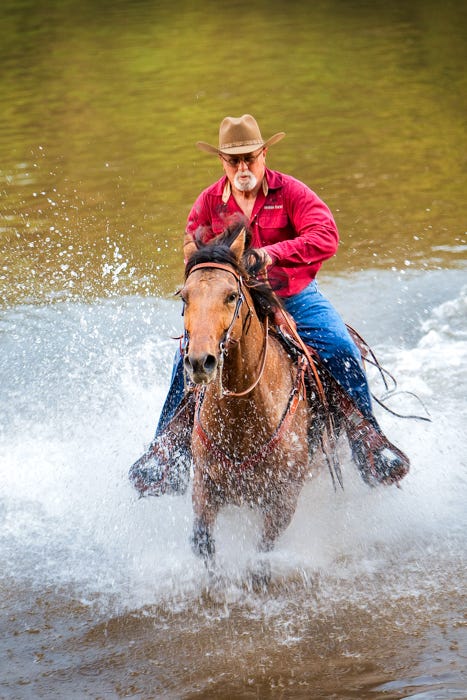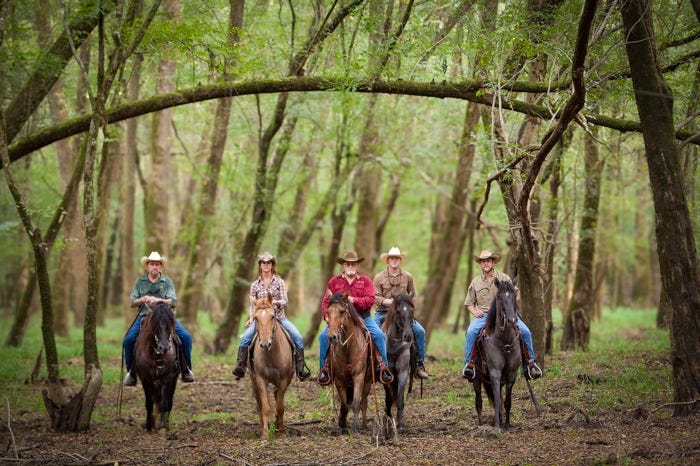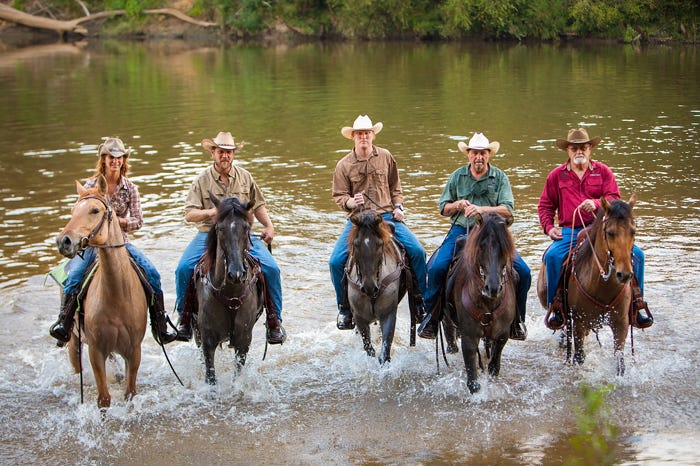A Horse for All Seasons
The steadfast Carolina marsh tacky holds a unique place in South Carolina’s heritage
By Tom Poland
There’s nothing so good for the inside of a man as the outside of a horse.
—Ronald Reagan
December in the Lowcountry
It’s a cold, blustery December morning. Three horsemen lean into a biting wind at renowned Oaklawn Plantation. With hollowed horns used to signal the other members of the hunting party strapped across their backs, they ride through widely-spaced stands of fire-blackened longleaf pine, the horses beneath them near invisible in the thick underbrush and tall grass that has sprung up since the last time these woods burned.
Their quest? Heritage and deer. Trailing a pack of eager dogs, the trio periodically drops out of the view of the standers placed strategically along the edges of the block of woods, only to emerge further downrange. Quietly weaving in and out of the thick underbrush, their movements take on an almost dreamlike quality.
Then suddenly, a whitetail breaks from cover. Whoops, hollers, and cracking whips shatter the morning’s calm. A cinematic blur of movement swirls through the trees. The horsemen rally the dogs to drive the deer toward standers and soon a salvo of shots reaps a deer.
A second drive gains three more deer, but one wounded buck flees, running hard towards a flooded cornfield managed for waterfowl, with the dogs in close pursuit. Two blows on the horn light a fire under the horsemen. Brothers Ed and Rawlins Lowndes and David Grant ride after the hounds in pursuit.
Rawlins Lowndes, commanding the hounds, rides Grant’s marsh tacky, “Sage,” and Grant rides “DP.” Ed Lowndes rides his tacky, “Laboka,” captured from a wild herd on Hilton Head Island. They have the right horse for the task at hand. For a solid week before the hunt, heavy rains have drenched the Lowcountry. The land surrounding the cornfield this morning is a muddy, obstacle-filled morass. Saplings, low-hanging limbs, tangled vines, armadillo holes, bushhog amputees—small-tree stubble—and thick, tall grass make the going rough for any horse. The marsh tacky, though, is not any horse.
The deer plunges into the flooded field with hounds in hot pursuit, and Rawlins Lowndes, carrying a shotgun borrowed from one of the standers, pounds around the edge of the dike surrounding the field, zigzagging between small trees and dodging low-hanging limbs. He urges Sage up the embankment, and up he goes—ten, maybe fifteen feet straight up—through thick grass studded with perilous holes.
Lowndes and Sage reach the far bank just ahead of the deer. Is a clean shot possible? On top, the dike is a narrow sliver, and it’s a long way down to the bone-chilling water. Lowndes weighs his options as the deer turns back, narrowly flanking the dogs. By this time, David Grant and DP have caught up, and Rawlins hands off the shotgun to Grant, who gallops off, trying once again to cut off the deer’s escape route.
Back home in the Pee Dee, Grant loves “ripping”—using the horses to flush deer and shooting them from the saddle. But not just any horse will do. It takes a very special horse like DP, one not easily spooked and calm enough to let his rider fire with accuracy. As the deer catapults up the dike, Grant closes in. BAM!
DP doesn’t even flinch.


A Horse for a Kingdom
Lowcountry hunting on horseback resonates with tradition, and that agile breed, the Carolina marsh tacky, boasts an enduring legacy as well. “Tacky” comes from an English word meaning “common” or “cheap.” Hogwash. A small band of men (and women), among them David Grant and Ed and Rawlins Lowndes, knows the horse is worth a king’s ransom. They hunt deer and wild hogs as men before them did, from horseback, and they fully intend to keep hunting atop the marsh tacky, a South Carolina tradition.
The Lowndes family has hunted on horseback for five generations. Grant owns and operates Carolina Marsh Tacky Outfitters near Darlington and breeds tackies. He brought three of his horses to a December hunt at Oaklawn, meaning something like 147 marsh tackies were elsewhere that day. The Carolina Marsh Tacky Outdoors estimates that a little over 300 pure marsh tackies exist.
Somewhere over the airwaves, an anthem plays for the marsh tacky, Procul Harum’s “Conquistador.” The song fits. As early as the 1500s, Spanish ships anchored along South Carolina’s coast. Their cargo included measles, small pox and chicken pox, but it also included fine-boned horses, a measure of absolution. The Spaniard’s colonies failed, and the would-be colonists left their horses to fend for themselves near Myrtle Beach and Port Royal. “Conquistador your stallion stands in need of company,” goes the song. Company it found.
In the 1600s, stunned English explorers, mouths agape, beheld Cherokee and Chickasaw Indians riding small, rugged horses. Feral marsh tackies sought refuge in Lowcountry marshes, where they were captured and domesticated, first by native people, then by European settlers and African slaves. The even-tempered horse made a good ride for children. The Gullah tilled their fields and gardens using tacky power. During World War II, beach patrols seeking Nazi U-boats rode marsh tackies. Had spies slipped ashore, men upon marsh tackies would have been the first line of defense. No surprise there. The horse had already ridden into the history books courtesy of an earlier war.
It’s believed that the legendary Swamp Fox, Francis Marion, led his irregulars into guerrilla-like forays on the sturdy-yet-nimble horses. Marsh Tackies would have easily outflanked the British Army’s larger European breeds in the woods and swamps of the South Carolina “backcountry.” Today the horses are used to pursue a quarry that’s a bit of a guerrilla fighter itself—wild Pee Dee hogs.
Hunting in the Pee Dee
It’s a Saturday, and today’s band of equestrians and hunters includes the Lowndes brothers, Grant, Richard Perdue, Bryan Stanton, Moultrie Helms, and guide Troy Byrd. Other participants in the hunt include tacky devotee Wylie Bell, assistant director of marketing communication at Richmond Community College, and equine photographer Dwain Snyder.




